Metamaterial Cell-Based Superstrate towards Bandwidth and Gain Enhancement of Quad-Band CPW-Fed Antenna for Wireless Applications
Abstract
1. Introduction
2. Metamaterial Unit Cell Design Architecture
3. Metamaterial Working Principle
4. Configuration of the Proposed Antenna
5. Experimental Results and Discussion
6. Conclusions
Author Contributions
Funding
Conflicts of Interest
References
- Sarkhel, A.; Mitra, D.; Chaudhuri, S.R.B. A compact metamaterial with multi-band negative-index characteristics. Appl. Phys. A 2016, 122, 471. [Google Scholar] [CrossRef]
- Li, D.; Szabó, Z.; Qing, X.; Li, E.-P.; Chen, Z.N. A high gain antenna with an optimized metamaterial inspired superstrate. IEEE Trans. Antennas Propag. 2012, 60, 6018–6023. [Google Scholar] [CrossRef]
- Engheta, N.; Ziolkowski, R.W. Metamaterials: Physics and Engineering Explorations; John Wiley & Sons: Hoboken, NJ, USA, 2006. [Google Scholar]
- Hasan, M.M.; Faruque, M.R.I.; Islam, M.T. Left-handed meta-surface loaded with ring resonator modelling for satellite application. Int. J. Satell. Commun. Netw. 2018, 36, 352–360. [Google Scholar] [CrossRef]
- Veselago, V.G. The Electrodynamics of Substances with Simultaneously Negative Values of Img Align= Absmiddle Alt = ϵ Eps/Img and μ. Phys. Uspekhi 1968, 10, 509–514. [Google Scholar] [CrossRef]
- Smith, D.R.; Padilla, W.J.; Vier, D.; Nemat-Nasser, S.C.; Schultz, S. Composite medium with simultaneously negative permeability and permittivity. Phys. Rev. Lett. 2000, 84, 4184. [Google Scholar] [CrossRef] [PubMed]
- Pope, S.A. Double negative elastic metamaterial design through electrical-mechanical circuit analogies. IEEE Trans. Ultrason. Ferroelectr. Freq. Control 2013, 60, 1467–1474. [Google Scholar] [CrossRef] [PubMed]
- Liu, J.; Bowler, N. Analysis of double-negative (DNG) bandwidth for a metamaterial composed of magnetodielectric spheres embedded in a matrix. IEEE Antennas Wirel. Propag. Lett. 2011, 10, 399–402. [Google Scholar]
- Armghan, A.; Hu, X.; Yuan, S.; Xia, J. Negative refractive index metamaterial structure using SRR by incidenting the light horizontally. J. Electromagn. Anal. Appl. 2015, 7, 276. [Google Scholar] [CrossRef]
- Wang, J.-J.; Gong, L.-L.; Sun, Y.-X.; Zhu, Z.-P.; Zhang, Y.-R. High-gain composite microstrip patch antenna with the near-zero-refractive-index metamaterial. Opt. Int. J. Light Electron. Opt. 2014, 125, 6491–6495. [Google Scholar] [CrossRef]
- Hwang, R.-B.; Hsu, N.-C.; Chin, C.-Y. A spatial beam splitter consisting of a near-zero refractive index medium. IEEE Trans. Antennas Propag. 2011, 60, 417–420. [Google Scholar] [CrossRef][Green Version]
- Dixit, A.; Tiwari, S.; Ramani, U.; Pandey, P.C. Refractive index sensor based on evanescent field effects in hollow core PCF for detection of analytes over extended E + S + C + L + U communication bands. Opt. Laser Technol. 2020, 121, 105779. [Google Scholar] [CrossRef]
- Alam, T.; Islam, M.T.; Cho, M. Near-zero metamaterial inspired UHF antenna for nanosatellite communication system. Sci. Rep. 2019, 9, 3441. [Google Scholar] [CrossRef] [PubMed]
- Alqadami, A.S.M.; Jamlos, M.F.; Soh, P.J.; Rahim, S.K.A.; Vandenbosch, G.A.; Narbudowicz, A. Miniaturized dual-band antenna array with double-negative (DNG) metamaterial for wireless applications. Appl. Phys. A 2017, 123, 22. [Google Scholar] [CrossRef]
- Myers, J.C.; Chahal, P.; Rothwell, E.; Kempel, L. A multilayered metamaterial-inspired miniaturized dynamically tunable antenna. IEEE Trans. Antennas Propag. 2015, 63, 1546–1553. [Google Scholar] [CrossRef]
- Booket, M.R.; Jafargholi, A.; Kamyab, M.; Eskandari, H.; Veysi, M.; Mousavi, S. Compact multi-band printed dipole antenna loaded with single-cell metamaterial. IET Microw. Antennas Propag. 2012, 6, 17–23. [Google Scholar] [CrossRef]
- Kim, O.S.; Breinbjerg, O. Miniaturised self-resonant split-ring resonator antenna. Electron. Lett. 2009, 45, 196–197. [Google Scholar] [CrossRef]
- Hasan, M.; Rahman, M.; Faruque, M.R.I.; Islam, M.T.; Khandaker, M.U. Electrically Compact SRR-Loaded Metamaterial Inspired Quad Band Antenna for Bluetooth/WiFi/WLAN/WiMAX System. Electronics 2019, 8, 790. [Google Scholar] [CrossRef]
- Su, L.; Naqui, J.; Mata-Contreras, J.; Martín, F. Modeling and applications of metamaterial transmission lines loaded with pairs of coupled complementary split-ring resonators (CSRRs). IEEE Antennas Wirel. Propag. Lett. 2016, 15, 154–157. [Google Scholar] [CrossRef]
- Almutairi, A.F.; Islam, M.S.; Samsuzzaman, M.; Islam, M.T.; Misran, N.; Islam, M.T. A Complementary Split Ring Resonator Based Metamaterial with Effective Medium Ratio for C-band Microwave Applications. Results Phys. 2019, 15, 102675. [Google Scholar] [CrossRef]
- Dong, Y.; Itoh, T. Metamaterial-based antennas. Proc. IEEE 2012, 100, 2271–2285. [Google Scholar] [CrossRef]
- Zhu, C.; Ma, J.-J.; Zhai, H.-Q.; Li, L.; Liang, C.-H. Characteristics of electrically small spiral resonator metamaterial with electric and magnetic responses. IEEE Antennas Wirel. Propag. Lett. 2012, 11, 1580–1583. [Google Scholar] [CrossRef]
- Islam, M.; Islam, M.; Samsuzzaman, M.; Faruque, M.; Misran, N.; Mansor, M. A miniaturized antenna with negative index metamaterial based on modified SRR and CLS unit cell for UWB microwave imaging applications. Materials 2015, 8, 392–407. [Google Scholar] [CrossRef]
- Chen, J.-P.; Hsu, P. A compact strip dipole coupled split-ring resonator antenna for RFID tags. IEEE Trans. Antennas Propag. 2013, 61, 5372–5376. [Google Scholar] [CrossRef]
- Ali, T.; Saadh, A.M.; Biradar, R.C.; Anguera, J.; Andújar, A. A miniaturized metamaterial slot antenna for wireless applications. AEU Int. J. Electron. Commun. 2017, 82, 368–382. [Google Scholar] [CrossRef]
- Rao, M.V.; Madhav, B.; Anilkumar, T.; Nadh, B.P. Metamaterial inspired quad band circularly polarized antenna for WLAN/ISM/Bluetooth/WiMAX and satellite communication applications. AEU Int. J. Electron. Commun. 2018, 97, 229–241. [Google Scholar]
- Ameen, M.; Chaudhary, R.K. Dual-layer and Dual-polarized Metamaterial Inspired Antenna using Circular-Complementary Split Ring Resonator Mushroom and Metasurface for Wireless Applications. AEU Int. J. Electron. Commun. 2019, 113, 152977. [Google Scholar] [CrossRef]
- Lin, J.; Qian, Z.; Cao, W.; Shi, S.; Wang, Q.; Zhong, W. A low-profile dual-band dual-mode and dual-polarized antenna based on AMC. IEEE Antennas Wirel. Propag. Lett. 2017, 16, 2473–2476. [Google Scholar] [CrossRef]
- Neebha, T.M.; Nesasudha, M. Analysis of an ultra miniature capsule antenna for gastrointestinal endoscopy. Eng. Sci. Technol. Int. J. 2018, 21, 938–944. [Google Scholar] [CrossRef]
- Zahraoui, I.; Zbitou, J.; Errkik, A.; Abdelmounim, E.; Tajmouati, A.; Latrach, M. Novel low cost compact printed antenna CPW-fed for GSM, GPS and PCS applications. In Proceedings of the 2015 Third International Workshop on RFID and Adaptive Wireless Sensor Networks (RAWSN), Agadir, Morocco, 13–15 May 2015; pp. 48–51. [Google Scholar]
- Li, H.; Zhou, Y.; Mou, X.; Ji, Z.; Yu, H.; Wang, L. Miniature four-band CPW-fed antenna for RFID/WiMAX/WLAN applications. IEEE Antennas Wirel. Propag. Lett. 2014, 13, 1684–1688. [Google Scholar] [CrossRef]
- Jo, G.J.; Mun, S.M.; Im, D.S.; Kim, G.R.; Choi, Y.G.; Yoon, J.H. Novel design of a CPW-FED monopole antenna with three arc-shaped strips for WLAN/WiMAX operations. Microw. Opt. Technol. Lett. 2015, 57, 268–273. [Google Scholar] [CrossRef]
- Pandeeswari, R.; Raghavan, S. A CPW-fed triple band OCSRR embedded monopole antenna with modified ground for WLAN and WIMAX applications. Microw. Opt. Technol. Lett. 2015, 57, 2413–2418. [Google Scholar] [CrossRef]
- Yoon, J.H. Triple-band CPW-fed monopole antenna with three branch strips for WLAN/WiMAX triple-band application. Microw. Opt. Technol. Lett. 2015, 57, 161–166. [Google Scholar] [CrossRef]
- Bag, B.; Biswas, P.; Mondal, R.; Biswas, S.; Sarkar, P. Circularly polarized quad-band monopole antenna of wireless communication system. Int. J. RF Microw. Comput. Aided Eng. 2019, 29, e21818. [Google Scholar] [CrossRef]
- Brar, R.S.; Saurav, K.; Sarkar, D.; Srivastava, K.V. A quad-band dual-polarized monopole antenna for GNSS/UMTS/WLAN/WiMAX applications. Microw. Opt. Technol. Lett. 2018, 60, 538–545. [Google Scholar] [CrossRef]
- Sethi, W.T.; Vettikalladi, H.; Fathallah, H.; Himdi, M. Hexa-band printed monopole antenna for wireless applications. Microw. Opt. Technol. Lett. 2017, 59, 2816–2822. [Google Scholar] [CrossRef]
- Ren, W.; Hu, S.-W.; Jiang, C. An ACS-fed F-shaped monopole antenna for GPS/WLAN/WiMAX applications. Int. J. Microw Wirel. Technol. 2017, 9, 1123–1129. [Google Scholar] [CrossRef]
- Al-Bawri, S.S.; Jamlos, M.F.; Soh, P.J.; Junid, S.A.A.S.; Jamlos, M.A.; Narbudowicz, A. Multiband slot-loaded dipole antenna for WLAN and LTE-A applications. IET Microw. Antennas Propag. 2017, 12, 63–68. [Google Scholar] [CrossRef]
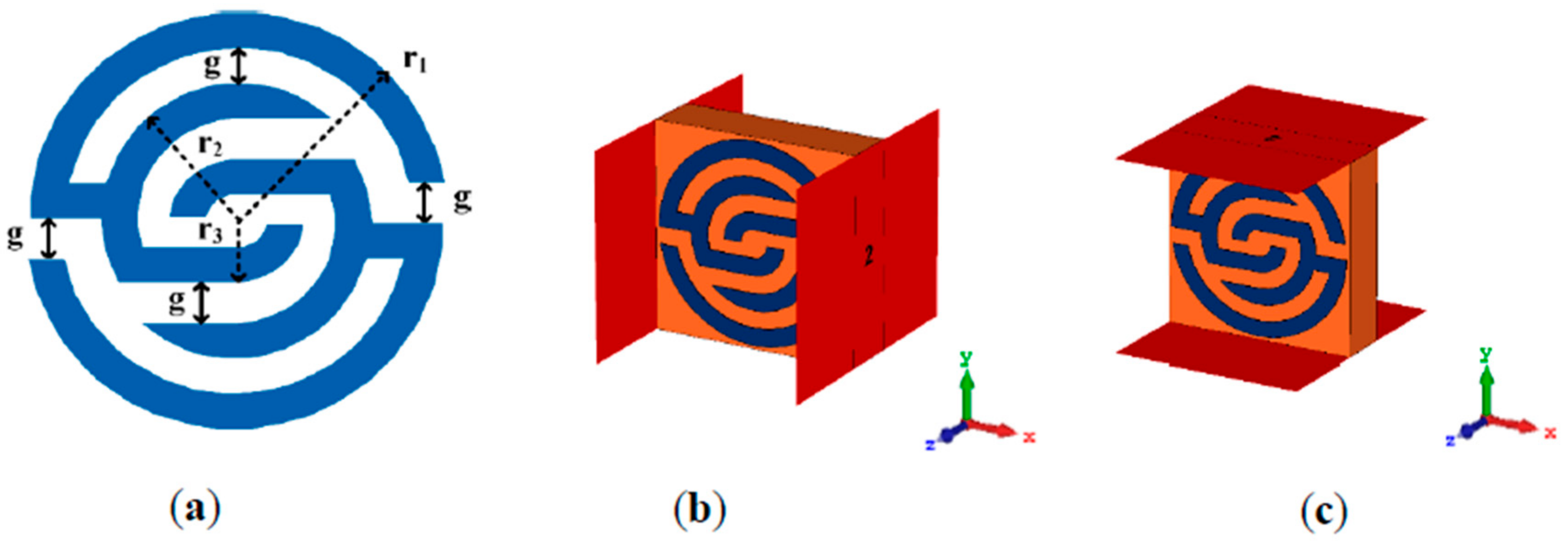
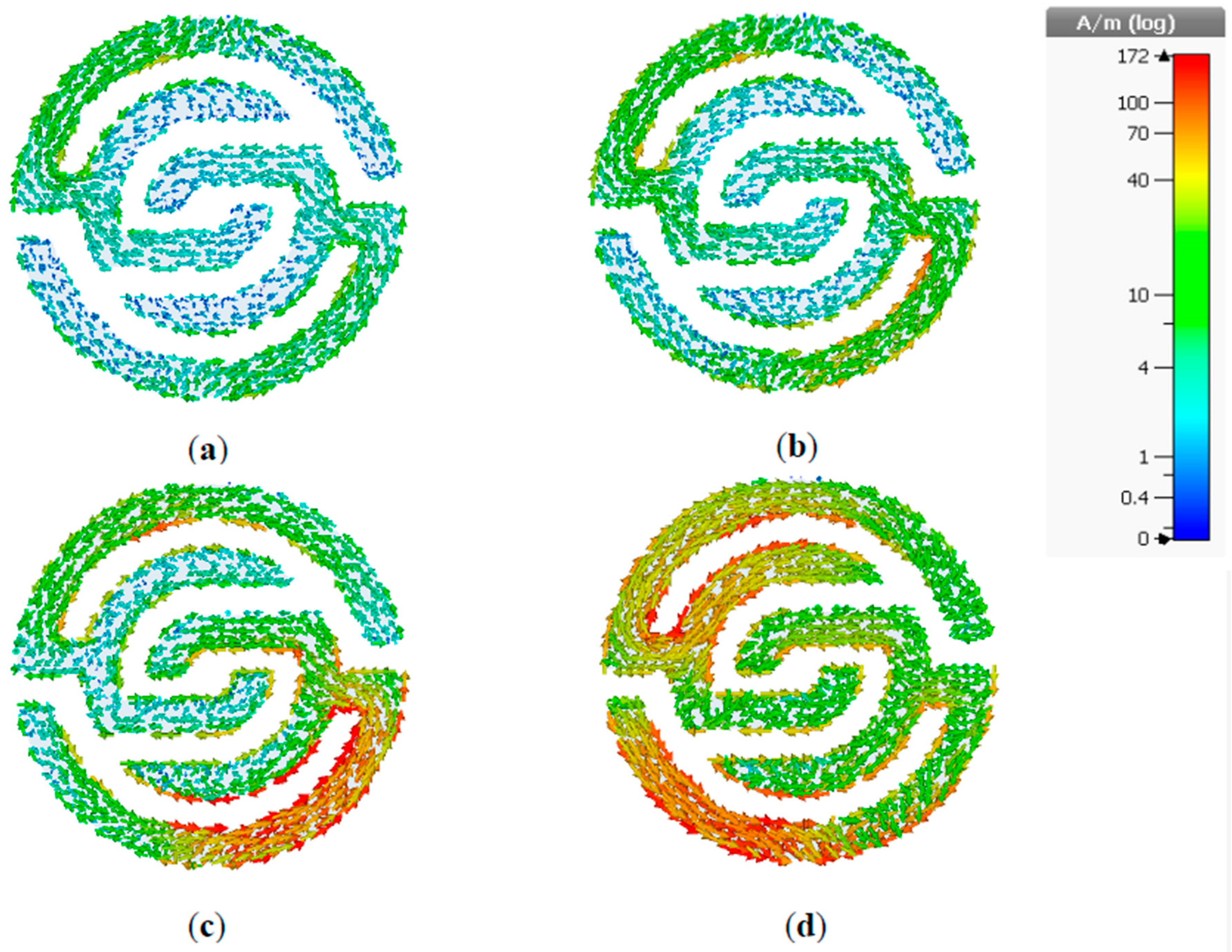
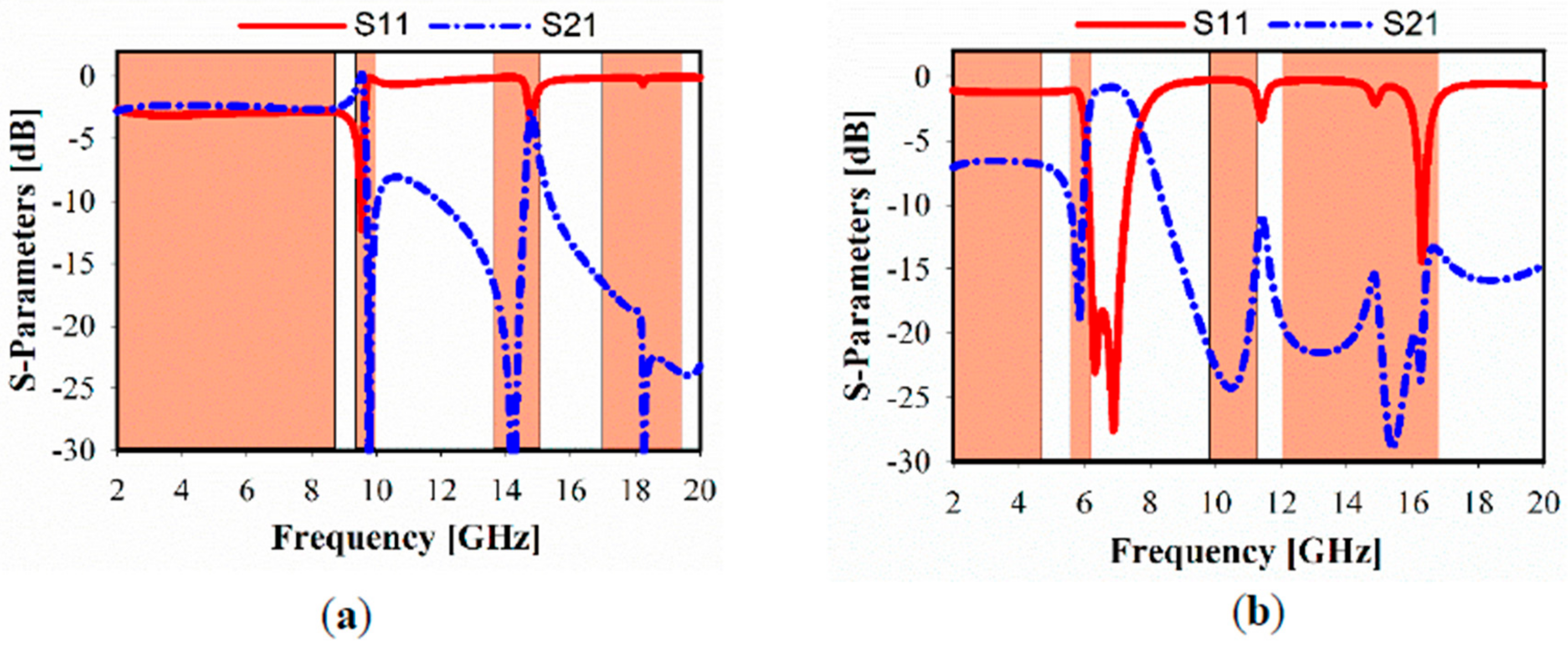
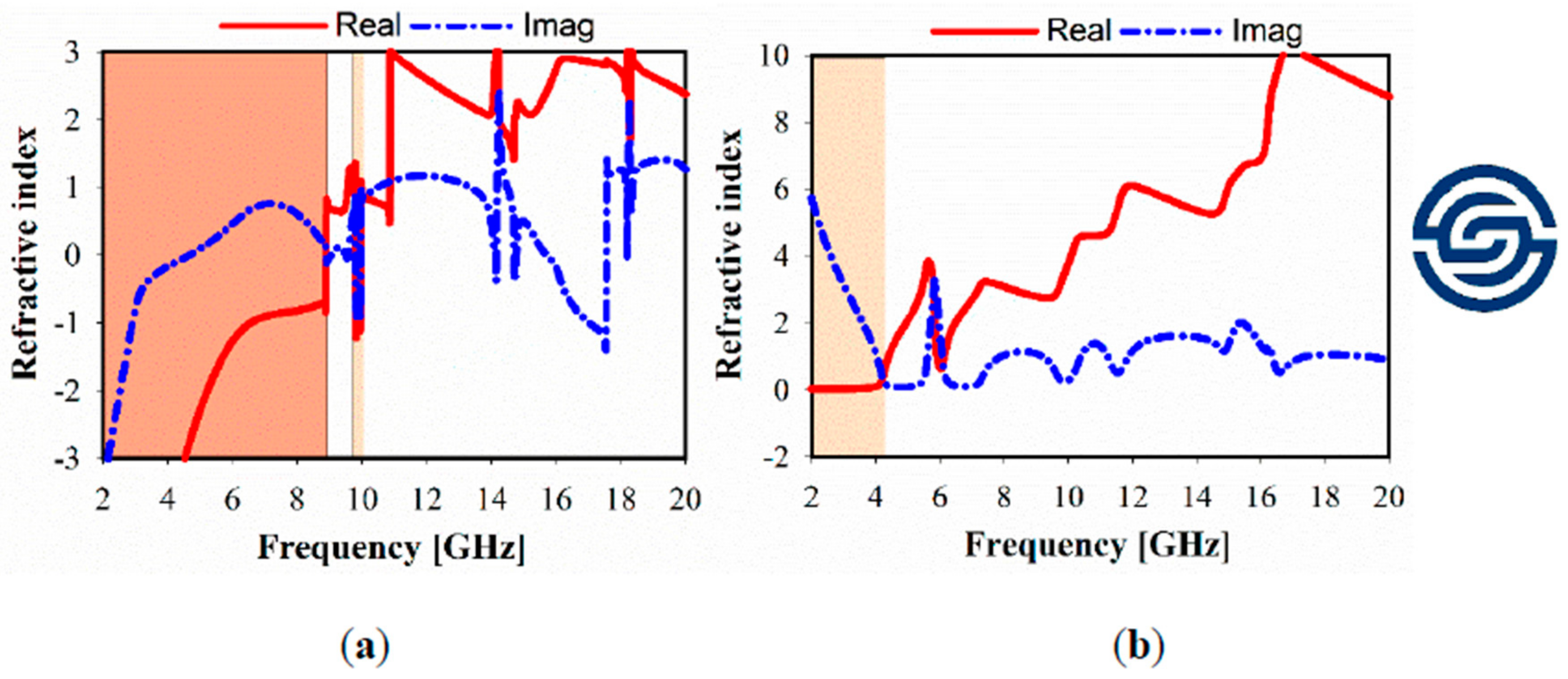


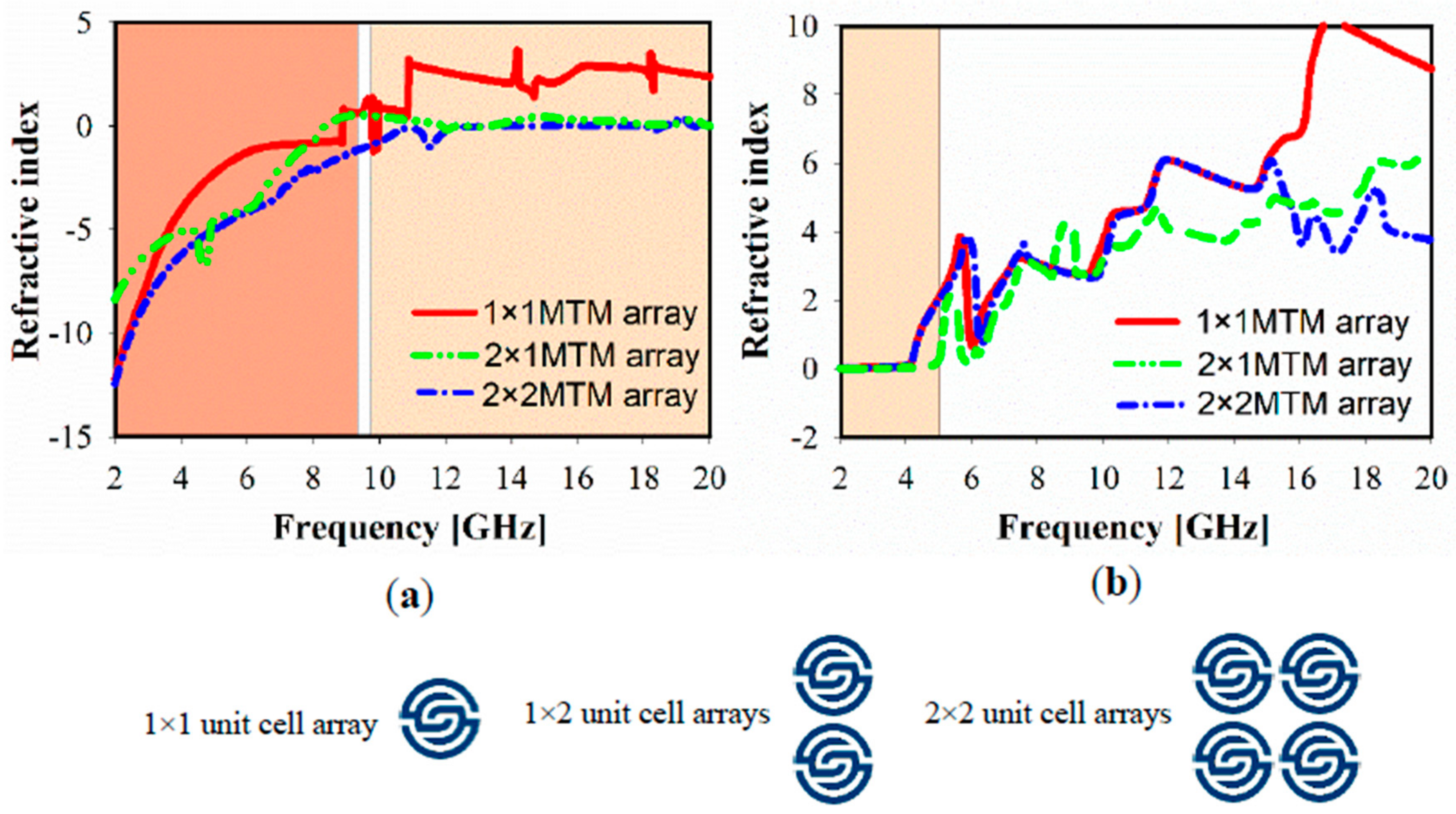
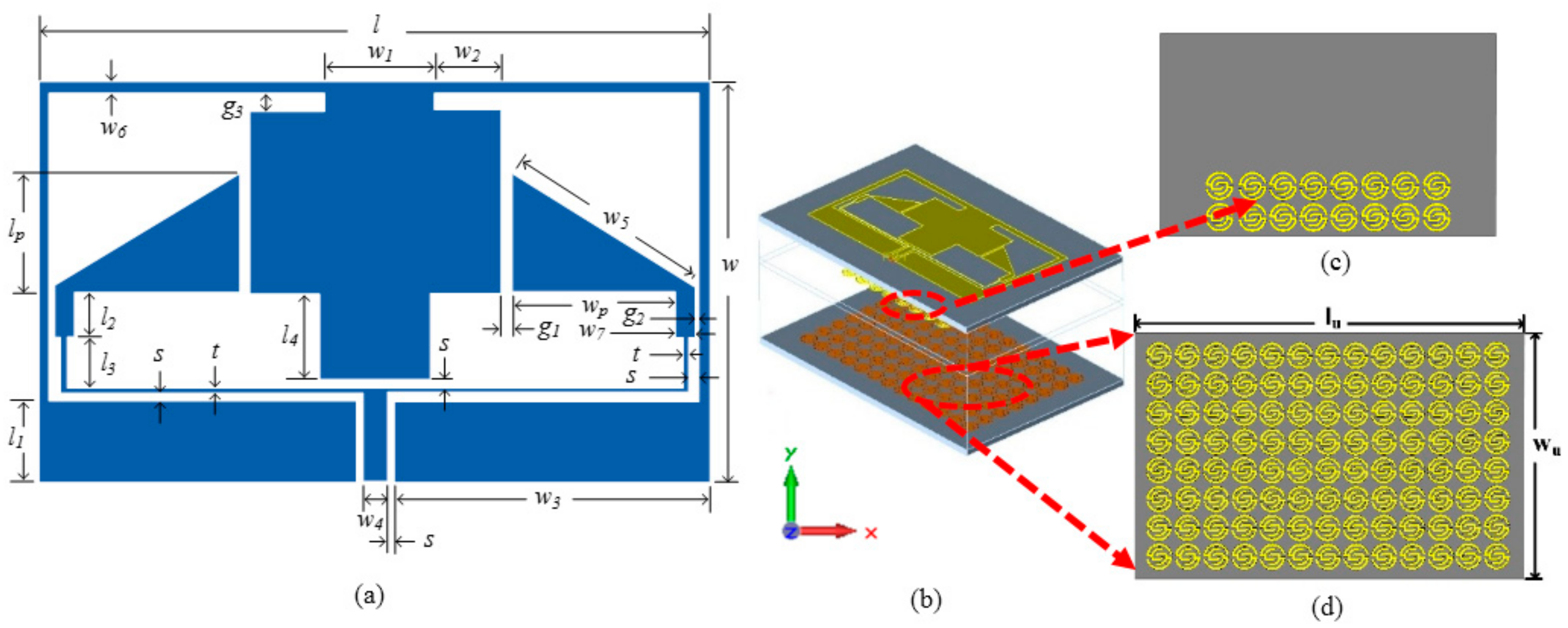
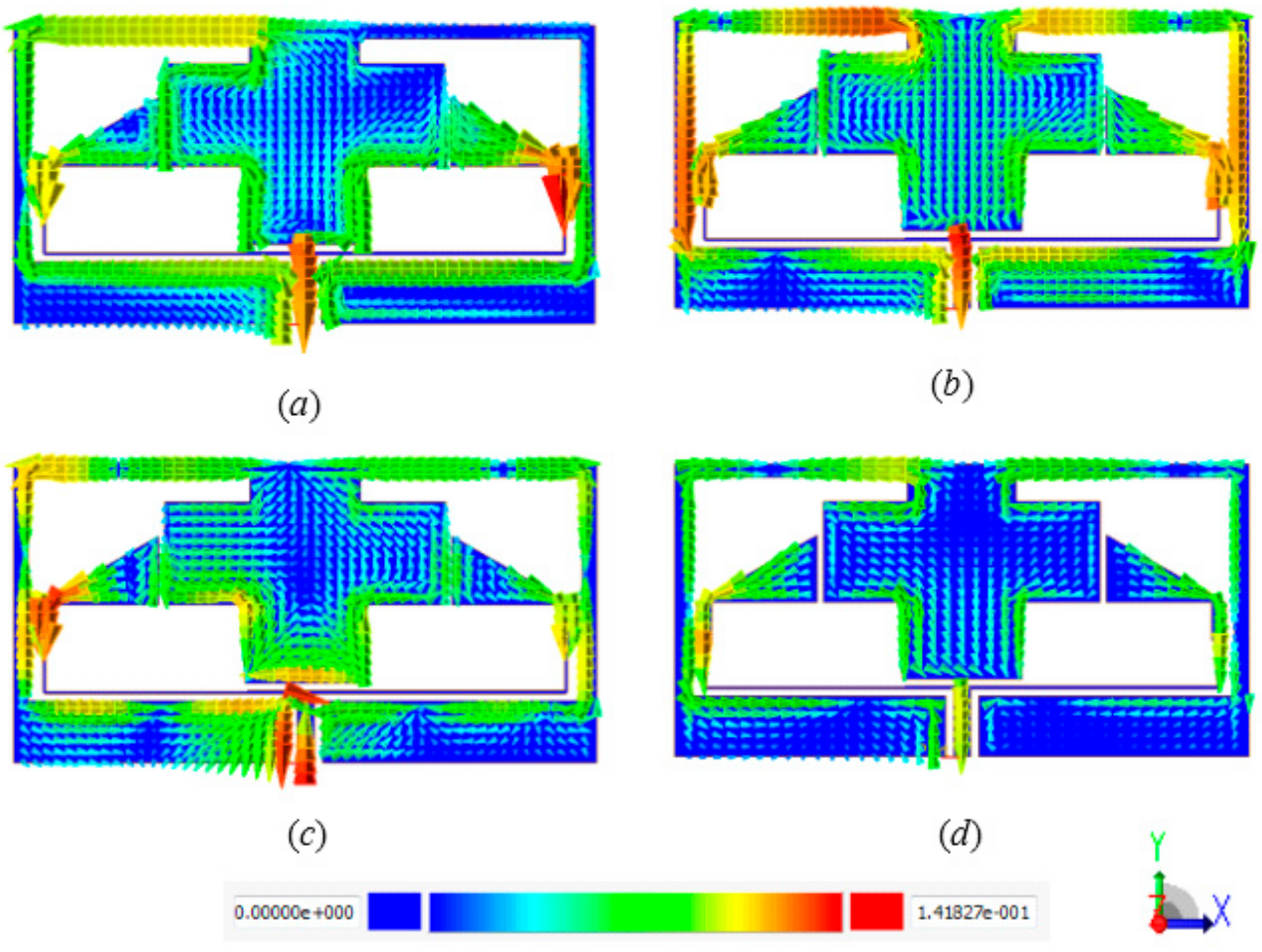
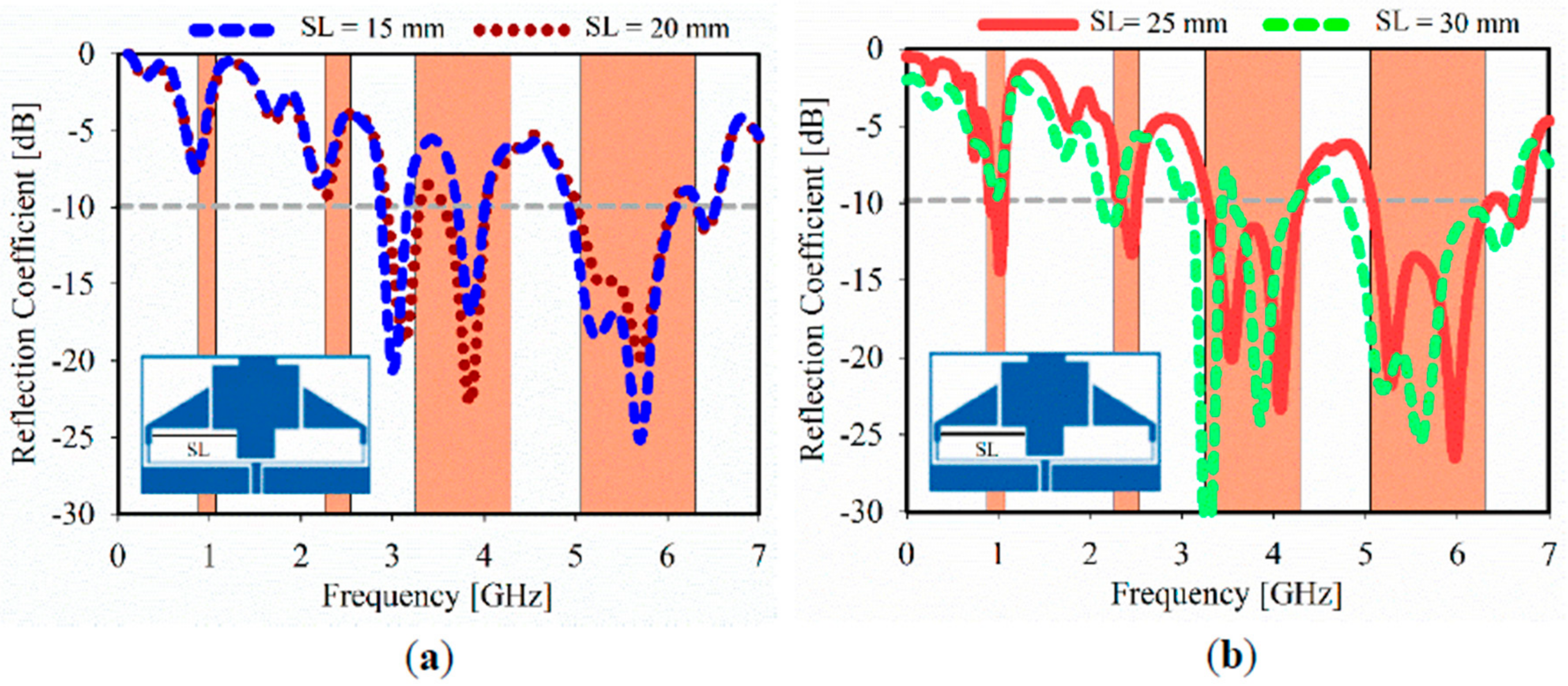
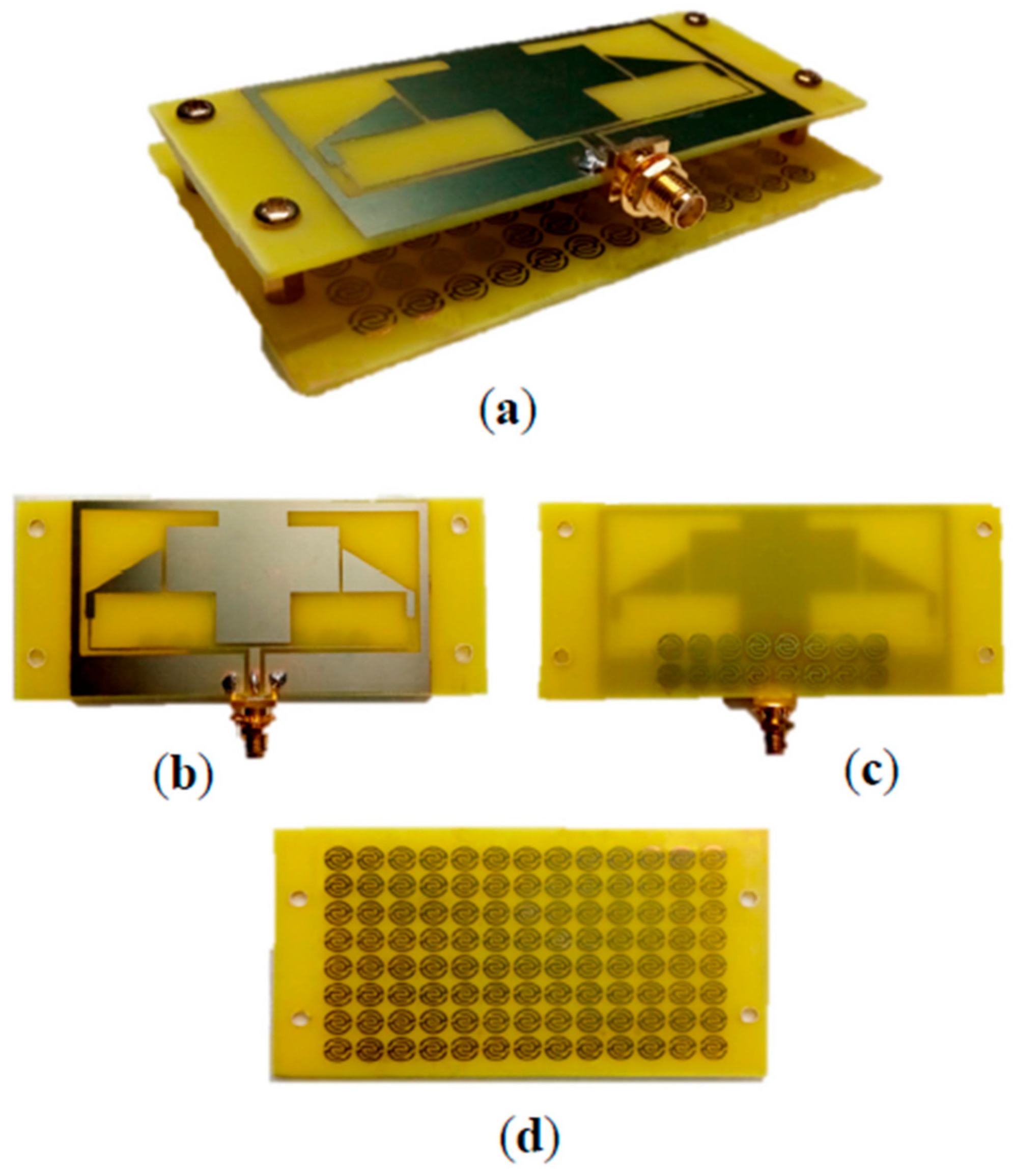
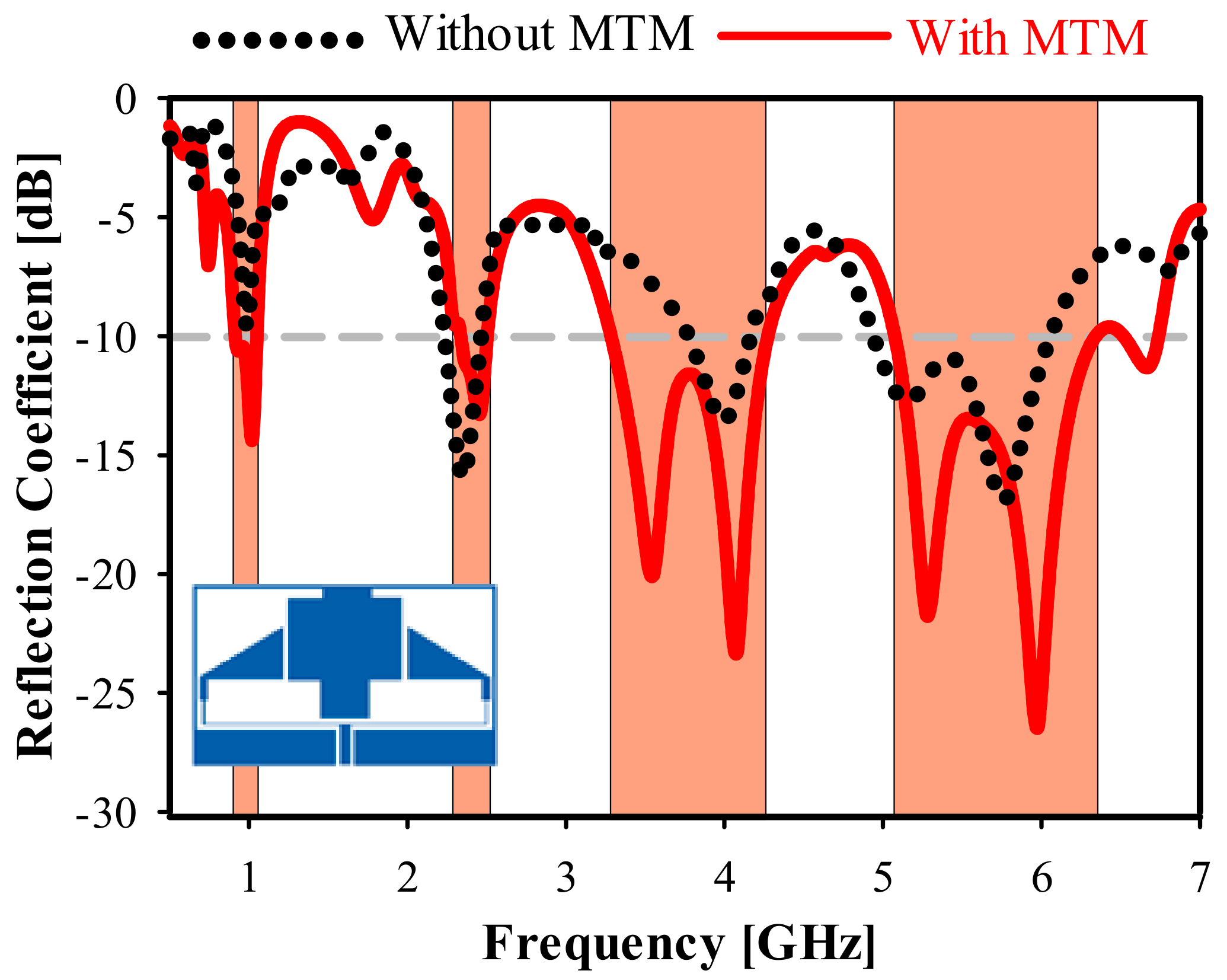
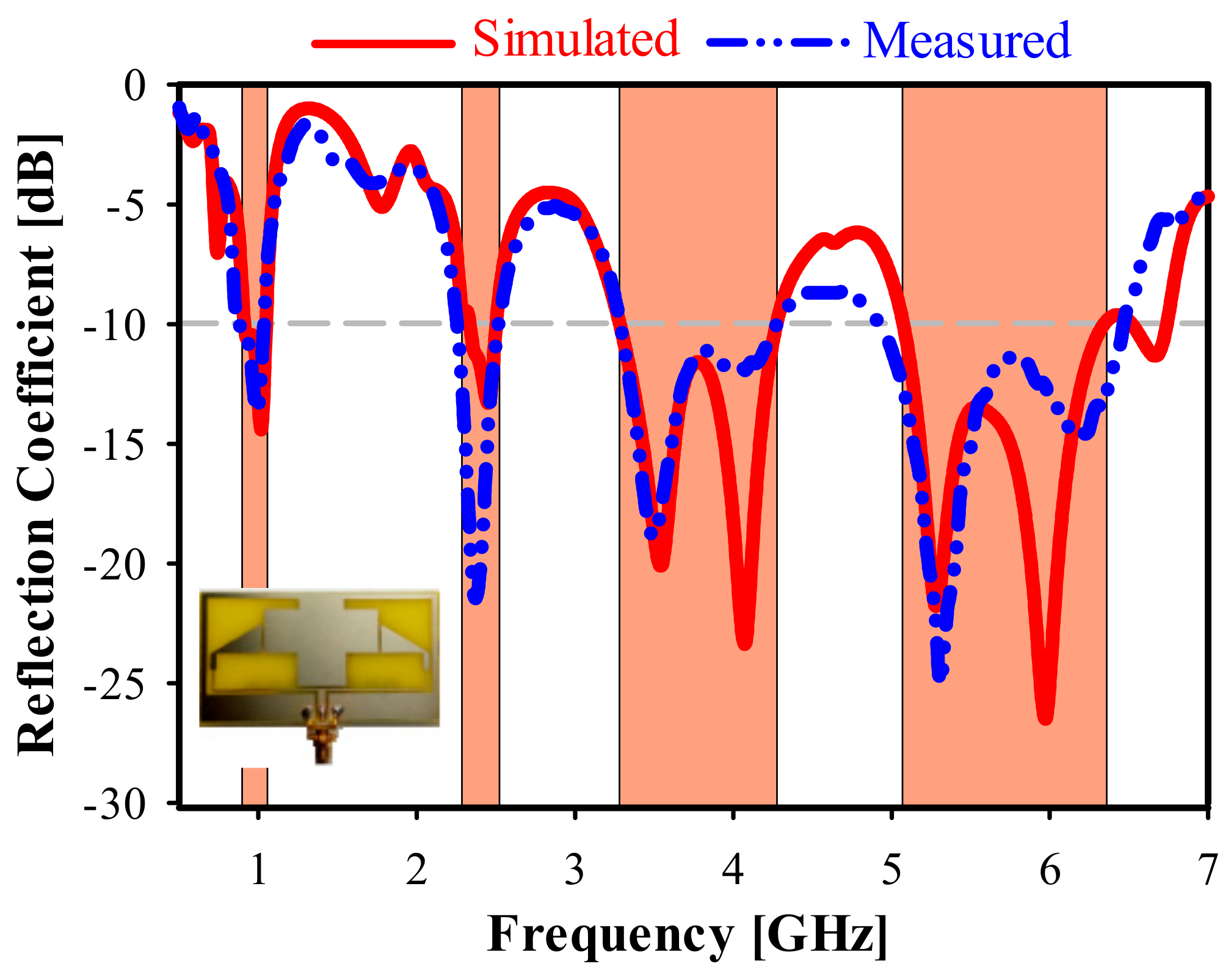
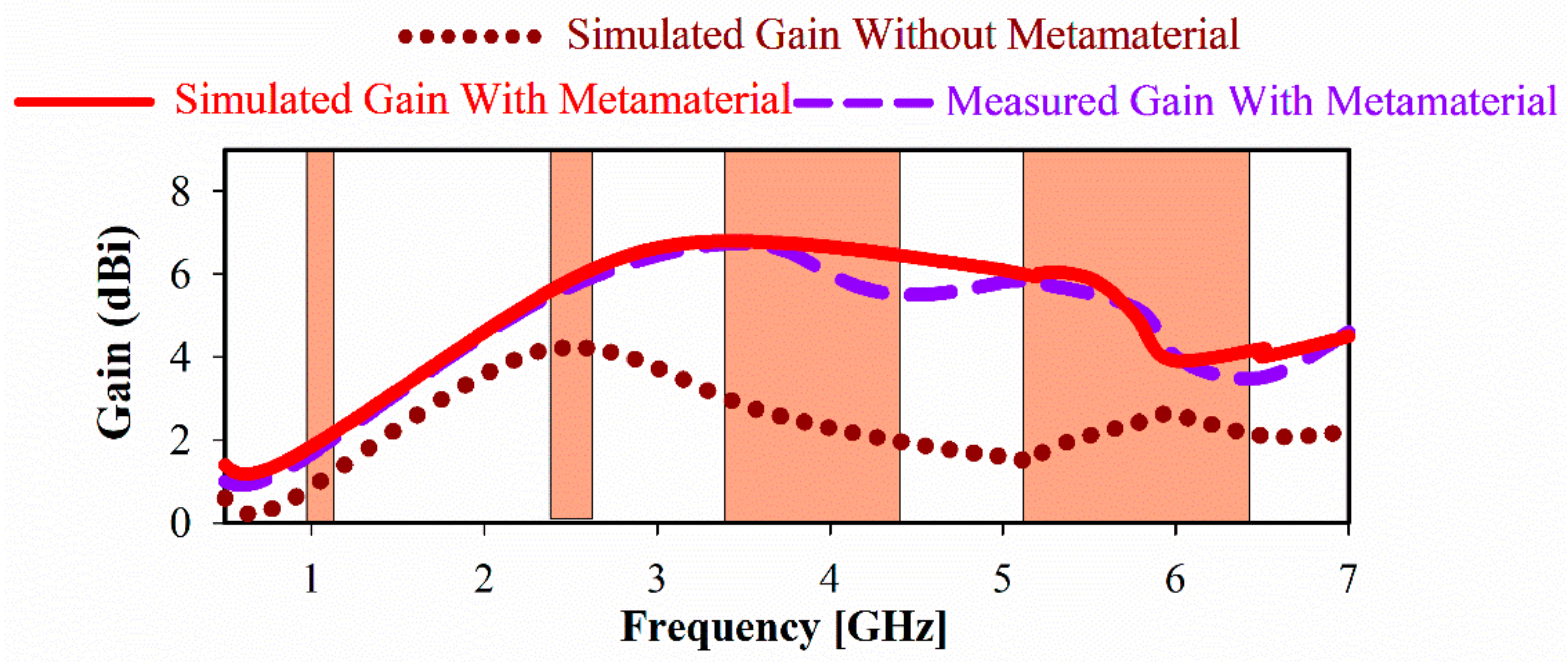
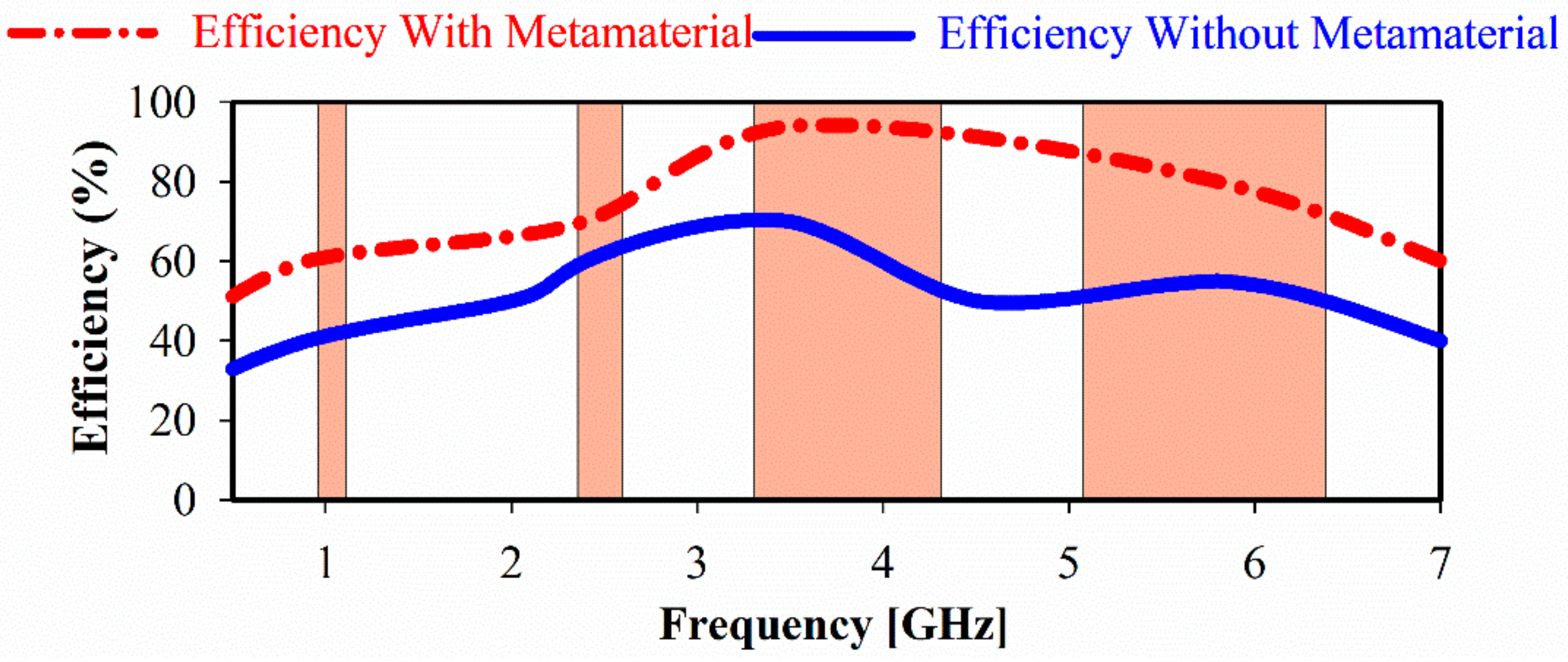
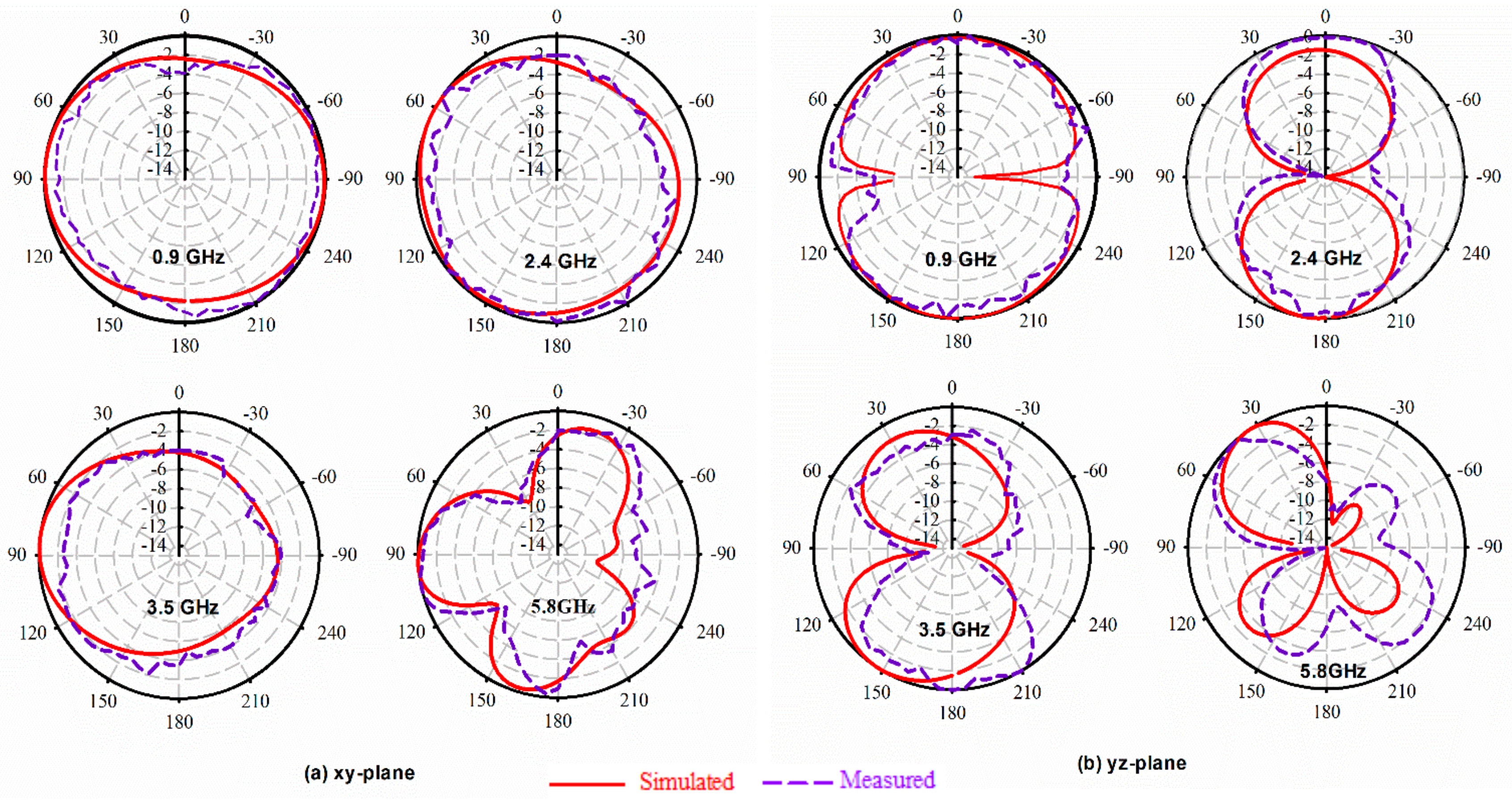
| Reference | Size (mm2) | Operating Bands (GHz) | Technique | Max. BW (%) | Max. Gain(dBi) |
|---|---|---|---|---|---|
| [30] | 45.0 × 45.5 | (0.898–0.929), (1.540–1.580), (1.956–2.005) | CPW-Fed | 02.47 | 2.72 |
| [31] | 30.0 × 30.0 | (0.918–0.927), (2.440–2.460), (3.520–3.620), (5.700–6.270) | U, L, F-shaped | 09.50 | 5.37 |
| [32] | 18.0 × 35.0 | (1.660–2.710), (2.950–4.540), (5.020–6.100) | CPW-Fed | -- | 5.27 |
| [33] | 30.0 × 40.0 | (2.400–2.700), (3.320–4.000), (4.760–5.800) | CPW-Fed & Slots | 19.70 | -- |
| [34] | 18.0 × 30.0 | (1.765–2.695), (3.010–3.910), (5.110–6.055) | CPW-Fed | 16.90 | 4.75 |
| [35] | 50.0 × 35.0 | (1.680–2.040), (3.030–4.100), (4.760–6.840), (7.620–8.420) | I-shaped strips | 35.80 | -3.50 |
| [36] | 50.0 × 69.0 | (1.430–1.600), (1.940–2.100), (2.400–2.570), (3.450–3.600) | L-shaped stub | 06.80 | 1.38 |
| [37] | 85.0 × 125 | (0.870–1.010), (1.720–1.960), (2.280–2.830), (5.710–6.380) | L-shaped radiator | 11.10 | 5.82 |
| [38] | 40.0 × 20.0 | (1.540–1.610), (2.310–2.720), (3.100–3.750), (5.030–5.950) | Asymmetric coplanar strip | 16.70 | 3.50 |
| [25] | 24.8 × 30.0 | (2.350–2.450), (2.630–2.760), (4.440–4.920), (5.420–5.770), (8.680–8.890) | Metamaterial | 10.25 | 3.01 |
| [26] | 32.0 × 38.0 | (2.400–2.600), (2.900–3.100), (3.300–3.500), (4.000–8.300) | Metamaterial | 11.11 | 3.80 |
| [27] | 48.0 × 48.0 | (1.710–1.880), (1.880–2.200), (3.400–3.800) | Metamaterial | 13.00 | 4.72 |
| [28] | 125 × 125 | (1.380–1.395), (1.570–1.580) | Artificial magnetic conductor (AMC) | 02.00 | 7.00 |
| This work | 78.6 × 42.5 | (0.865–1.060), (2.240–2.520), (3.250–4.310), (4.900–6.500) | NZRI & DNG Metamaterial | 28.00 | 6.72 |
| Para. | Value (mm) | Para. | Value (mm) | Para. | Value (mm) | Para. | Value (mm) | Para. | Value (mm) |
|---|---|---|---|---|---|---|---|---|---|
| l | 78.6 | g1 | 0.766 | l2 | 5.53 | w3 | 37.1 | t | 0.42 |
| w | 42.5 | g2 | 1.108 | l3 | 6.506 | w4 | 2.44 | s | 1 |
| lp | 9.87 | g3 | 3.4 | l4 | 11 | w5 | 19.14 | ||
| wp | 14.4 | l1 | 8.86 | w1 | 15 | w6 | 2 | ||
| wu | 55 | lu | 88 | w2 | 11.5 | w7 | 2 |
| Frequency Band (GHz) | 0.9 | 2.4 | 3.5 | 5.5 |
| Gain (dBi) | 1.89 | 5.05 | 6.74 | 5.98 |
| Bandwidth (%) | 20.26 | 11.76 | 27.81 | 28 |
| Efficiency (%) | 62 | 71 | 95 | 83 |
| Size (mm) | 78.6 × 42.5 × 0.035 m3 | |||
© 2020 by the authors. Licensee MDPI, Basel, Switzerland. This article is an open access article distributed under the terms and conditions of the Creative Commons Attribution (CC BY) license (http://creativecommons.org/licenses/by/4.0/).
Share and Cite
Al-Bawri, S.S.; Islam, M.S.; Wong, H.Y.; Jamlos, M.F.; Narbudowicz, A.; Jusoh, M.; Sabapathy, T.; Islam, M.T. Metamaterial Cell-Based Superstrate towards Bandwidth and Gain Enhancement of Quad-Band CPW-Fed Antenna for Wireless Applications. Sensors 2020, 20, 457. https://doi.org/10.3390/s20020457
Al-Bawri SS, Islam MS, Wong HY, Jamlos MF, Narbudowicz A, Jusoh M, Sabapathy T, Islam MT. Metamaterial Cell-Based Superstrate towards Bandwidth and Gain Enhancement of Quad-Band CPW-Fed Antenna for Wireless Applications. Sensors. 2020; 20(2):457. https://doi.org/10.3390/s20020457
Chicago/Turabian StyleAl-Bawri, Samir Salem, Md Shabiul Islam, Hin Yong Wong, Mohd Faizal Jamlos, Adam Narbudowicz, Muzammil Jusoh, Thennarasan Sabapathy, and Mohammad Tariqul Islam. 2020. "Metamaterial Cell-Based Superstrate towards Bandwidth and Gain Enhancement of Quad-Band CPW-Fed Antenna for Wireless Applications" Sensors 20, no. 2: 457. https://doi.org/10.3390/s20020457
APA StyleAl-Bawri, S. S., Islam, M. S., Wong, H. Y., Jamlos, M. F., Narbudowicz, A., Jusoh, M., Sabapathy, T., & Islam, M. T. (2020). Metamaterial Cell-Based Superstrate towards Bandwidth and Gain Enhancement of Quad-Band CPW-Fed Antenna for Wireless Applications. Sensors, 20(2), 457. https://doi.org/10.3390/s20020457







